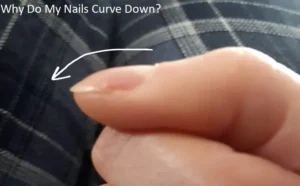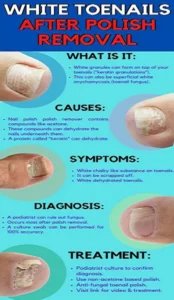Gel nail polish is popular for its long-lasting finish and vibrant colors, but some people may experience an allergic reaction to it. The chemicals found in gel nail polishes, particularly in the curing process, can trigger skin allergies and cause discomfort. If you’re experiencing an allergic reaction to gel nail polish, understanding the symptoms and treatment options can help you manage the situation effectively.
Key Takeaways
- Allergic reactions to gel nail polish can cause rash, swelling, and itching.
- Stopping the use of the allergen is the first step in treating the reaction.
- Over-the-counter antihistamines and cortisone creams can help reduce the symptoms of a gel polish allergy.
- In severe cases, a dermatologist may prescribe stronger medicine or other treatments.
What Causes an Allergic Reaction to Gel Nail Polish?
The chemicals in gel nail polishes are the main allergens that cause allergic reactions. These chemicals, such as acrylates, are used in the curing process when the gel polish is hardened under UV or LED light. When these allergens come into contact with the skin or nails, they can trigger an allergic reaction.
Common Allergens in Gel Nail Polish
- Acrylates: Commonly found in gel nail polish, this is the most frequent allergen that causes reactions.
- Methacrylate: Another chemical used in the curing process, which can lead to irritation and allergic symptoms.
- Formaldehyde: Found in some nail polishes, it can cause skin reactions in sensitive individuals.
| Chemical Allergen | How It Affects You |
|---|---|
| Acrylates | Causes most gel polish allergies |
| Methacrylate | Triggers skin irritation and swelling |
| Formaldehyde | Can lead to rashes, redness, and allergic reactions |
Symptoms of a Gel Nail Polish Allergy
f you’re experiencing an allergic reaction to gel nail polish, the symptoms will often appear around the nail bed, fingertips, or skin near the nails. In some cases, the reaction can spread to other parts of the body.
Common Symptoms
- Redness and swelling around the nails
- Itching or burning sensation
- Blisters or rash around the nail area
- Skin peeling near the nails
- Hives or more severe rashes in other areas
These symptoms can occur immediately after the gel manicure or take a few days to appear. If left untreated, gel nail allergies can worsen and lead to more serious skin problems.
How to Treat an Allergic Reaction to Gel Nail Polish?
If you are dealing with an allergic reaction to gel nails, quick and effective treatment is essential. Here’s a step-by-step guide to treating gel nail allergies.
Stop Using the Gel Polish
The first and most important step is to stop using the gel polish. Remove the gel polish as soon as you notice an allergic reaction. It’s essential to avoid using gel polishes in the future to prevent recurring reactions.
Use Antihistamines
Over-the-counter antihistamines can help relieve itching and swelling. These medications work by blocking the effects of histamine, a chemical your body releases during an allergic reaction.
How to Use:
- Take as directed on the package.
- Use antihistamines like Benadryl for quick relief of symptoms like itching and hives.
Apply Cortisone Cream
A mild cortisone cream can be applied directly to the affected area to reduce redness, swelling, and itching. These creams help soothe the skin and alleviate discomfort caused by allergic reactions.
How to Use:
- Apply a thin layer of cortisone cream to the affected area 2-3 times a day.
- Avoid using near the eyes or mouth.
Keep the Area Clean and Moisturized
Ensure the skin around your nails is clean and hydrated to prevent further irritation. Wash the area with mild soap and water, and apply a fragrance-free moisturizer to keep the skin healthy.
Avoid Further Exposure to Gel Nail Products
To prevent future allergic reactions, it’s essential to stop using gel nail polishes. Look for hypoallergenic nail polish options or opt for regular nail polish instead.
| Treatment Option | How It Helps |
|---|---|
| Antihistamines | Reduces itching and swelling |
| Cortisone Cream | Soothes redness and inflammation |
| Moisturizer | Keeps skin hydrated and promotes healing |
Home Remedies for Gel Nail Allergies
If you prefer natural treatments, there are a few home remedies that can help soothe the symptoms of a gel nail allergy.
Aloe Vera Gel
Aloe vera is known for its soothing properties and can help reduce swelling and redness around the nails. Apply fresh aloe vera gel to the affected area 2-3 times a day for relief.
Oatmeal Soak
An oatmeal soak can help calm irritated skin and reduce itchiness. Mix colloidal oatmeal with warm water and soak your hands for 10-15 minutes.
Coconut Oil
Coconut oil acts as a natural moisturizer and helps to heal dry, irritated skin caused by the allergic reaction. Apply it to the affected area to reduce inflammation and promote healing.
| Natural Remedy | Benefits |
|---|---|
| Aloe Vera | Reduces redness and soothes the skin |
| Oatmeal Soak | Calms irritation and reduces itching |
| Coconut Oil | Moisturizes and heals damaged skin |
When to See a Doctor
In some cases, gel nail polish allergies can cause more severe reactions that require medical attention. If your symptoms worsen or don’t improve with over-the-counter treatments, it’s important to consult a healthcare provider. You may need prescription-strength creams or medication to treat the reaction effectively.
Signs You Should Seek Medical Help:
- Severe swelling or pain around the nails
- Blisters that don’t heal
- Symptoms spreading to other areas of the body
Conclusion
An allergic reaction to gel nail polish can be uncomfortable and frustrating, but it can be treated with the right approach. By stopping the use of gel nails, using antihistamines and cortisone creams, and keeping the affected area clean and moisturized, you can manage the symptoms and prevent further reactions. If the symptoms persist, seek medical advice to ensure a proper treatment plan is in place.








